[dropcap]M[/dropcap]utari chocolate popped up three years ago with high-end sipping chocolate that delighted local taste buds. A couple of years ago, they sold the business to Katy Oursler and Stephen Beaumier, who have made some changes, like a new location next to Assembly. The biggest news is the introduction of their White Label chocolate bar line. Oursler explained to us why its top-of-the-line stuff.
What’s the difference between White Label chocolate and high-end bars you can find on grocery shelves?
KATY OURSLER: One of the big differences between two- or three-ingredient bars and what’s on the shelf is we don’t use soy lecithin. A lot of folks use a lot of cocoa butter. We keep our cocoa butter to a minimal amount, under 5 percent. It dilutes the experience of the origin; it mutes some of those nuances. We don’t use a vanilla. You would be surprised at how much you associate the taste of chocolate with vanilla when you start consuming bars that don’t have vanilla. Most of our bars are two-ingredient bars: Cacao and sugar. It’s more dynamic. You can taste the origin. I compare it to winemaking.
Do you have specific beans you work with, or does it change all the time?
There are some staples and communities that we find that folks are drawn to that we keep on our menus. For example, our Madagascar bar and are Tanzanian bar, those are two very likeable origins. The Tanzanian is pretty quintessential roast-y chocolate-y. Whereas the Madagascar is bright, red berry fruit, raspberry. And I usually find that folks’ palates fall into one of those two categories. They like the heavier chocolate-y roast, or they like the brighter, more acidic fruit-forward and floral. We do keep some basics on the menu, and then we experiment. We just brought in some beans from India, from Anamalai, which we’re very excited about. I think a better or more interesting bean and bar is our Honduras, La Masica. We won an International Chocolate Award for it last year. It comes from FHIA (Fundacion Hondureña de Investigación Agrícola) in Honduras, which is an incredible cacao gene bank with a plethora of pure genetic strains and subsequent clones. It’s places like this, with its robust breeding/cloning programs, that will enable cacao to be more resilient to climate change while also not losing its fine flavor.
Factory & House is at 504 Front St. A, Santa Cruz, 687-8141; Winter Shop at 1108 Pacific Ave., Santa Cruz. Open Friday, Saturday and Sundays. mutarichocolate.com.













